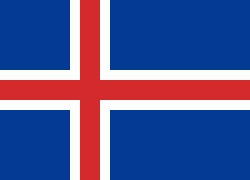Greater Reykjavík (Höfuðborgarsvæði)
The region contains Iceland's far largest urban area, Greater Reykjavík (Stór-Reykjavík), a conurbation that includes parts of six out of seven municipalities of the region (Kjósarhreppur is all rural).
Seven municipalities make up the Capital Region with Reykjavík being the most populated by far with 135,688 inhabitants. Kjósarhreppur is the largest municipality by area (287.7 km2) but is entirely rural and only has 244 inhabitants. Seltjarnarnes is the smallest municipality with an area of 2.3 km2.
Map - Greater Reykjavík (Höfuðborgarsvæði)
Map
Country - Iceland
 |
 |
| Flag of Iceland | |
According to the ancient manuscript Landnámabók, the settlement of Iceland began in 874 AD when the Norwegian chieftain Ingólfr Arnarson became the first permanent settler on the island. In the following centuries, Norwegians, and to a lesser extent other Scandinavians, immigrated to Iceland, bringing with them thralls (i.e., slaves or serfs) of Gaelic origin.
Currency / Language
| ISO | Currency | Symbol | Significant figures |
|---|---|---|---|
| ISK | Icelandic króna | kr | 0 |
| ISO | Language |
|---|---|
| DA | Danish language |
| EN | English language |
| DE | German language |
| IS | Icelandic language |
| NO | Norwegian language |
| SV | Swedish language |















